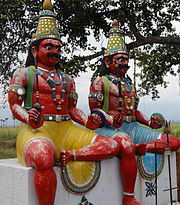Religion in Tamil Nadu
Religion in Tamil Nadu (2011)[1] As per the Sangam literature, the Sangam landscape (300 BCE to 300 CE) was classified into five categories known as thinais, which were associated with a Hindu deity: Murugan in kurinji (hills), Thirumal in mullai (forests), Indiran in marutham (plains), Varunan in the neithal (coasts), and Kotravai in palai (desert).[14][15] In rural areas, local deities, called Aiyyan̲ār (also known as Karuppan, Karrupasami), are worshipped who are thought to protect the villages from harm.[19] [20] Majority of the available literature from the Sangam period was Hindu and categorized in the tenth century CE into two categories based roughly on chronology as the patiṉeṇmēlkaṇakku ("the eighteen greater text series") comprising Ettuthogai (or Ettuttokai, "Eight Anthologies") and the Pattuppāṭṭu ("Ten Idylls").[28][29][30] Bharatanatyam is a major genre of Indian classical dance that originated in Tamilakam and is represented to invoke Nataraja, a form of Shiva.[31][32] There are many folk dance forms that originated and are practiced in the region which are done in veneration to Hindu gods and goddesses such as Kavadiattam,[33][34] Mayilattam,[35][36] Bhagavatha nadanam, Devarattam, Kai silambattam, Kuravanji and Urumiattam.[52] The Group of Monuments at Mahabalipuram, built by the Pallavas in the 7th and 8th centuries has more than forty rock-cut temples and monoliths including one of the largest open-air rock reliefs in the world.[58] Pancha Bhuta Sthalam refers to temples dedicated to Shiva, each representing a manifestation of the five prime elements of nature.[70] The Santhome Church, which was originally built by the Portuguese in 1523, is believed to house the remains of St. Thomas and was rebuilt in 1893 in neo-Gothic style.[77][78] The 16th-century Basilica of Our Lady of Good Health is located at Velankanni, about 12 km (7.5 mi) south of Nagapattinam on the Eastern coast.[1] The Kilakarai Jumma Masjid, built in the 7th century CE, has prominent Dravidian architectural characteristics and is one of the oldest mosques in India.[86] Erwadi houses an 840-year-old mosque and the annual santhanakoodu festival held during the Islamic month of Dhul Qidah attracts people of all faiths from different regions.[98] Kalugumalai consist of three rock-cut temples–Kalugumalai Jain Beds, Vettuvan Koil and Kalugasalamoorthy Temple, with rock relief sculptures dating back to Pandya period of 8th to 9th century.





TamilsHistory of Tamil NaduHistory of Sri LankaSources of ancient Tamil historySangam periodKeezhadi excavation siteTamilakamAgricultureEconomyEducationIndustryChronology of Tamil historyTamil KingdomsTamilizationCultureLanguageLiteraturePhilosophyScriptNumeral systemMedicineArchitectureCuisineCalendarCinemaPeopleIndian TamilsSri Lankan TamilsMalaysian TamilsSingapore TamilsTamil diasporaIndian Tamil diasporaSri Lankan Tamil diasporaMalaysian Tamil diasporaTamil AustraliansFrench TamilsBritish TamilsTamil ItaliansTamil IndonesiansTamil CanadiansTamil AmericansTamil South AfricansMyanmar TamilsTamil MauritiansTamil GermansTamil PakistanisTamil SeychelloisTamil New ZealandersSwiss TamilsDutch TamilsReligion in ancient Tamil countryTamil HinduHinduism in Tamil NaduHinduism in Sri LankaTamil BuddhismTamil JainTamil MuslimChristianity in Tamil NaduPolitics of Tamil NaduDravidian nationalismTamil NationalismSri Lankan Tamil nationalismHinduismChristianMuslimChristianityJainismSikhismBuddhismSangam literatureSangam landscapeMuruganThirumalIndiranVarunanKotravaiSangam eraTamil pantheonPandyasPallavasSaivismVaishnavismBhakti movementAlwarsNayanmarsmathasAiyyan̲ārParvatiPillayarMariammanmother goddessTamil culturehumanistbronzefrescoesmuralsNatarajaBharatanatyampatiṉeṇmēlkaṇakkuEttuthogaiPattuppāṭṭuTirukkuralThiruvalluvarRamavataramKambarTiruppugalArunagirinatharNadaswaramreed instrumentthavildrum instrumentCarnatic musicIndian classical dancefolk danceKavadiattamMayilattamKoothuRamayanaMahabharataPongalharvest festivalPuthanduTamil calendarKarthikai DeepamThaipusamAadi Perukku
